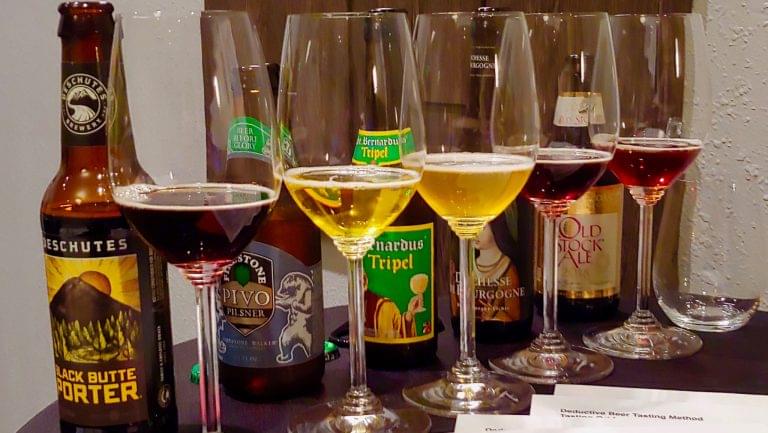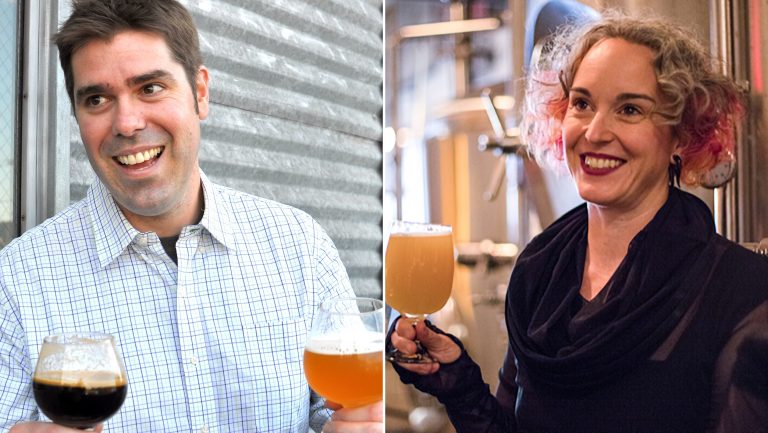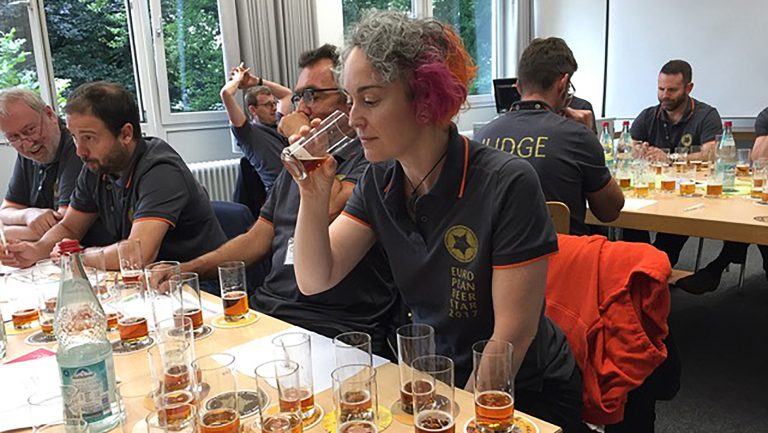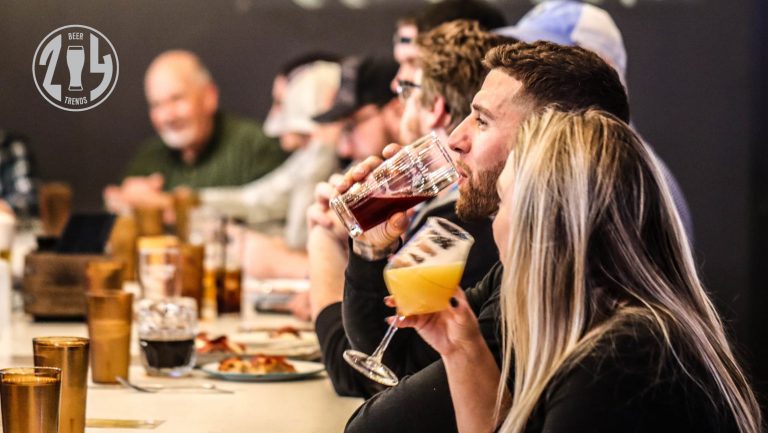It’s far too easy to lean on vague beer descriptors like funky, hoppy, and sour when selling beer. While those terms have some use, describing specific flavors is much more helpful, and a proper blind tasting is one of the best ways to learn how to assess a beer’s true flavors and aromas.
Advanced Cicerone Jen Blair, who is also a beer judge and a writer based in Charlotte, North Carolina, suggests that blind-tasting beer can be illuminating. “It’s the best palate training there is—and one that is fairly inexpensive for retailers to do,” she says. “If you don’t know how a beer tastes, how can you accurately tell your customers about the product? How do you know your store is selling an acceptable product if you’re not tasting it for possible problems?”
Blind tasting also helps staff learn the particulars of what sets a beer apart on a crowded shelf without the influence of marketing. Master Cicerone Rich Higgins, based in San Francisco, explains that blind tasting can help beer professionals be more impartial when critically evaluating products. “The more you know about a beer ahead of time,” he says, “the harder it is to taste objectively. Taste is such a subjective experience.”

Don’t miss the latest drinks industry news and insights. Sign up for our award-winning newsletters and get insider intel, resources, and trends delivered to your inbox every week.
Without establishing a structure and parameters, a blind tasting is just blind drinking. Free resources like Higgins’s guide, Deductive Beer Tasting Method, can provide a full framework, but at its most basic, a proper blind tasting addresses four aspects of a beer: appearance, aroma, mouthfeel, and flavor.

What to Look for in a Beer’s Appearance
Beer color comes primarily from the malt—specifically, the type and roast level of the grain. It can be a style indicator, though it can also be misleading in a world of black IPAs and blonde stouts.
In general, the color spectrum in beer can be broken down into yellow, amber (or red), brown, and black, which all provide hints about the beer’s flavor. Yellow-to-gold beers, like lagers, typically have cereal and bread notes. Amber ales, some darker pale ales, and IPAs typically have a toffee note and a fuller body than light-colored beers. You can expect caramel and chocolate from brown ales and deep brown-to-black ales, in addition to coffee in the latter.
It’s also important to look at the clarity of a beer, as it can indicate style, type of malt used, or potential flaws. Lagers are golden and clear, for example, while wheat beers are golden and cloudy. If you’re looking at a cloudy pilsner, that generally means something went wrong during the brewing process. Clarity is less important for dark beers, but when it comes to IPAs, the clarity can immediately indicate the brewer’s style—West Coast IPAs are clear (regardless of whether it’s a dark yellow or light amber color), and New England IPAs are hazy.
Assessing the head also helps a drinker deduce the beer’s style. Hops, glassware, alcohol level, and proteins from the malt can all impact the head of a beer. Wheat and oat beers normally have more proteins and longer head retention, while beers that use adjunct grains like corn and rice have less retention. Hops help create a longer-lasting head, so expect more foam and lacing on the side of the glass as you drink a high-hopped IPA. Many high-alcohol beers have low head retention, says Advanced Cicerone Mandy Naglich, who is based in New York City, but there are examples that buck that trend, like Duvel. Finally, the glass itself can be a factor in head retention: A dirty glass with oil or residual soap can decrease head retention regardless of style.

The old cliché of tasting first with your eyes holds true, however, for the broadest first impressions. Just don’t put too much faith in what you see, says Mirella Amato, a Master Cicerone based in Toronto and the author of Beerology: Everything You Need to Know to Enjoy Beer. “It depends on the beer,” she says. “In terms of quality, it’s dangerous to make any assumptions based on appearance.” For instance, barrel-aged stouts may have a similar color as Irish stouts, for example, but you can expect the former to have a higher alcohol content and thicker consistency—something you won’t know until assessing the aroma and flavor.
How a Beer’s Aroma Indicates Style
It’s hard to overstate what you can learn from thoughtfully smelling beer. Andrew Luberto, an Advanced Cicerone and Beer Judge Certification Program (BJCP) judge who is based on Long Island, New York, says, “Aroma is everything.”
One way to assess aroma is the long-distance sniff, which is the preferred method of Rachael Hudson, an Advanced Cicerone and the head brewer and co-owner of Pilot Brewing Co. in Charlotte, North Carolina. First, swirl the beer with one hand while covering the glass with your other to trap the aromas. Then, smell the beer from a distance and slowly bring it closer to your nose while noting the aromas you detect at different distances.
The potential aromas in a beer are vast. Hops, yeast, and malt all add different characteristics. Amato suggests determining which ingredient dominates the aroma and digging into the specifics of that primary aroma before moving on to the next. Depending on the hop variety, the ingredient will add lemon, grapefruit, and other citrus (like with Mosaic and Citra hops), pine (Centennial and Cascade hops), or stone and tropical fruit (Galaxy and Motueka). Yeast produces esters during fermentation that can add banana notes in the case of hefeweizens, and other fruit notes like apple and peach can be found in ales fermented with wild yeast. For malty aromas, smelling is the first check on the assumptions you made based on appearance. Typical light lagers will have a crisp cracker note, for example, while dark ales like stouts and porters will have malty aromas like chocolate, coffee, and toffee.
How these flavors interact can suggest style. Beer styles with a hop-forward aroma include pale ales and IPAs, and IPAs with more malty aromas are typically West Coast style while more hop aromas indicate a New England style. When the yeast aromas are more prominent, it’s a good sign of wheat beers and wild yeast ales. The BJCP has a worksheet that describes the aromas typical for every major style, and there’s a BJCP app with the information as well.
Properly assessing aroma in a way that’s helpful to determine style and describe a beer to a customer is all about specificity. This means relating what you smell to ingredients, food, and places.
“It’s more helpful,” says Naglich, “to say ‘This tastes like lemon pie’ than to say ‘This is made with lacto-bacteria and very old hops.’” She suggests getting away from typical descriptors and adds, “As soon as you’re able to say it kind of smells like soy sauce or a dark steak, many people around you will be like, ‘Yeah, that’s what I smell.’”
It may seem unnatural to describe a beer as meaty, but specific terms are the most useful way to help consumers pick a beer that aligns with their taste preferences. “If you tell me the IPA on the menu is hoppy, that could mean a lot of things,” says Neal Ryan, a Certified Cicerone and a sales manager at Boise Brewing in Idaho. “It’s also based upon your opinion. But if you tell me it has 50 IBU, [is] floral with notes of tropical fruit, [and has] bitterness that disappears quickly, and a clean finish, I know exactly what I’m buying.”

Understanding Mouthfeel
Mouthfeel is primarily broken down into carbonation, body, astringency, and creaminess, says Blair. In addition to helping determine style—whether a beer is a thin lager or a syrupy imperial stout—mouthfeel can help determine if a beer is true to style. Traditional saisons have high carbonation, for example, while barrel-aged beers have low carbonation. Other characteristics to note are the warming sensation from higher alcohol and the drying sensations imparted by barrel aging.
Comparing Taste to Other Sensations
After you assess appearance and aroma, taste the beer to confirm your notes. “You want to have your retronasal olfaction [functions] working along with all the different taste buds in your mouth,” Ryan says. “You can only do that by drinking the beer.”
Unlike blind-tasting wine or spirits, it’s important to swallow beer. Swallowing is the best way to experience retronasal olfaction—the smells you get at the back of your throat, where you’ll pick up aromatic compounds.
Taste, along with aroma, also lets you pinpoint off-flavors. These include 3-MBT (skunky, from exposure to light), acetaldehyde (green apple), diacetyl (buttered popcorn), dimethyl sulfide (or DMS, which smells like creamed corn), and a cardboard or waxy lipstick smell from oxidation.
To better understand off-notes, Hudson suggests buying a kit of off-flavors that you can put in a neutral beer to learn how to detect them through blind tasting. “It’s important,” she says, “to be able to recognize them when you’re trying to sell a beer.”
Overall, learning flavors through blind tasting helps you better explain a beer to consumers. “Some breweries are really faithful about what their beer tastes like, while some sort of use sleight of hand,” Higgins says. “They say, ‘Hey, this beer is really smooth.’ More evocative descriptors drive a consumer to purchase that beer.”

Dispatch
Sign up for our award-winning newsletter
Don’t miss the latest drinks industry news and insights—delivered to your inbox every week.
Nickolaus Hines is a journalist who writes about beer, spirits, food, and travel. He’s the food and drinks editor at Matador Network and has written about drinks for Liquor.com, Men’s Health, October, Hop Culture, Supercall, and VinePair.







